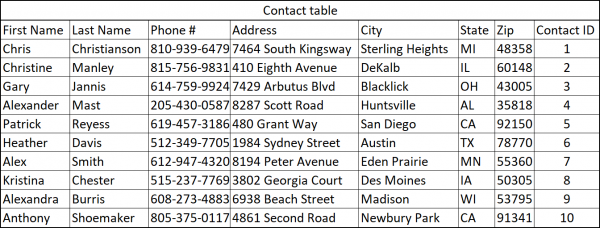- What is a database?
- A simple definition of a database is a collection of organized data.
- So, by that definition, if you throw your receipts into a shoe box, is that a database?
- Well, it is a collection of data, but it is not really organized, so no it is not a database.
- So, since a telephone book has information, and it is organized alphabetically, is it a database?
- The answer is Yes – the old fat white-page phone book with an alphabetical list of names, addresses and phone numbers is a database. But, unlike modern databases, the phone book is not an electronic database.
- So, what is an electronic database – just organized information on a computer?
- Yes, an electronic database is organized information held on a computer.
- Wait a minute. I was told that Excel was a spreadsheet and not a database. But the information is organized, so you are claiming that Excel is a database, right?
- Technically speaking Excel is a spreadsheet program – it is not a database. But the information you put into Excel is a database, provided you keep it organized. If you put all the first names in one column, and all the last names in another… if you make sure to keep the phone numbers in a phone number column, and if you do not enter notes into any column except a notes column, then Yes, your spreadsheet is a two-dimensional database.
- What do you mean two-dimensional? Are there three-dimensional and four-dimensional databases?
- Great question – yes, many databases have two, three, four, or even more dimensions. In fact, modern, electronic, relational databases are multi-dimensional.
- A database kept in a spreadsheet is two dimensional because the data flows up and down and left and right. Thus, the first dimension is the columns, and the second dimension is the rows.
- In a spreadsheet, the columns are the equivalent of database fields. The rows are the equivalent of database records. The sheet is the equivalent of a table.
- You said, “relational database”, what is that?
- A relational database is composed of multiple tables where the information in one table is related to the information in another table. For example, your database might have a table for your contacts and include fields (columns) for first name, last name, phone number, address, city, state, zip, etc. Your database might then have a second table to keep track of phone calls you have made to the contacts. This second table would probably have fields for contact date, contact time, and notes about what you discussed. You would then link or relate the two tables together by adding a common contact ID field to both tables. This would allow the database to easily keep track of which phone call was made to which contact.


- That sure sounds like a lot of work. Wouldn’t I be better off just putting it into my spreadsheet?
- It is a lot of work, but only for the computer. For the end user it is easy because the database designer can create a user-friendly interface form that makes it simple and effortless to find and record the information.

TechMentors love to answer questions about databases, spreadsheets, and desktop software. If you have a question, please contact us.
